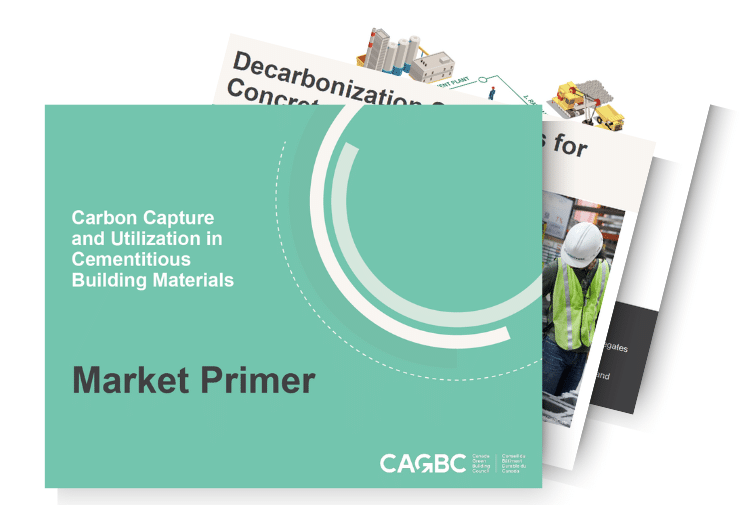CAGBC releases Market Primer on burying carbon in buildings
- Theme
- Advocacy
CAGBC has been rallying industry to reduce embodied carbon in buildings. Building materials generate environmental impacts throughout their life cycle, including during their production, transportation, manufacturing, installation, maintenance, and disposal at end of life.
Today, embodied carbon from building construction accounts for as much as 10 percent of global emissions. In some cases, concrete materials can be the single largest contributor to the embodied carbon of new buildings and infrastructure due to the sheer quantity of concrete required and its emissions intensity. In Canada and around the world, low-carbon concrete is in high demand, as are solutions to leverage cement and concrete for carbon storage.
Today, carbon capture and utilization in cementitious building materials or CCU-CBM, is an essential strategy for decarbonization. Carbon capture, or the separation of carbon dioxide (CO2) from industrial processes, ensures carbon isn’t released into the atmosphere. Carbon utilization converts those captured emissions into valuable materials – including those used in the construction of buildings and infrastructure. CCU-CBM technologies shows so much promise that the Cement Association of Canada reported it is expected to account for more than 25 percent of the cement and concrete industry’s necessary reductions in carbon emissions.
“Meeting Canada’s climate targets will require an ‘all in’ approach from all sectors of our national economy,” said Laurna Strikwerda, Director of Project Development & Research at the Canada Green Building Council (CAGBC). “We know that substantial carbon emissions are released in the process of manufacturing cement, and traditional strategies such as the use of renewable energy or improved production efficiency, while important, will not fully eliminate them. It will also take unique strategies like carbon capture and utilization to maximize reductions.”
CAGBC been studying the potential of CCU-CBM as part of its “Burying Carbon in Buildings” research project. The project was initiated to help Canada’s building sector understand available CCU-CBM technologies, market challenges and opportunities, and provide guidance to advance market adoption.
Recently, CAGBC released a market primer summarizing this research on the status of CCU-CBM technologies in the Canadian market. Carbon Capture and Utilization in Cementitious Building Materials: Market Primer provides an introduction to CCU-CBM technologies in Canada and outlines the potential role these technologies could play in decarbonizing the building sector. The primer is a first step in a broader project which includes research from the University of Toronto (U of T) to help identify and advance promising CCU-CBM solutions. The resulting research findings will complement efforts by designers, producers, policymakers, industry, municipalities, and governments to advance solutions and a roadmap for low-carbon cement and concrete construction, and aid in the life cycle analysis of buildings and infrastructure.

“Carbon capture can shift from a cost of business for emitters to an economic opportunity,” said Strikwerda. “By developing technologies that put CO2 in market-viable products, Canada’s construction and infrastructure sectors can benefit financially while driving meaningful climate action.”
In addition to the primer, CAGBC will produce market-facing guidance exploring the specification and procurement of CCU-CBM. Targeted to the design, construction, and development industry, the development of this resource will be led by CAGBC with support from UofT and other project partners. It will explore the responsibilities of key stakeholders such as architects, structural engineers, product manufacturers, and general contractors in specification and procurement.
Interested in learning more? CAGBC is hosting a live webinar April 15th exploring learnings from the Primer. Attendees will gain insights into how Carbon Capture and Utilization in Cementitious Building Materials (CCU CBM) can help meet Canada’s climate goals.
